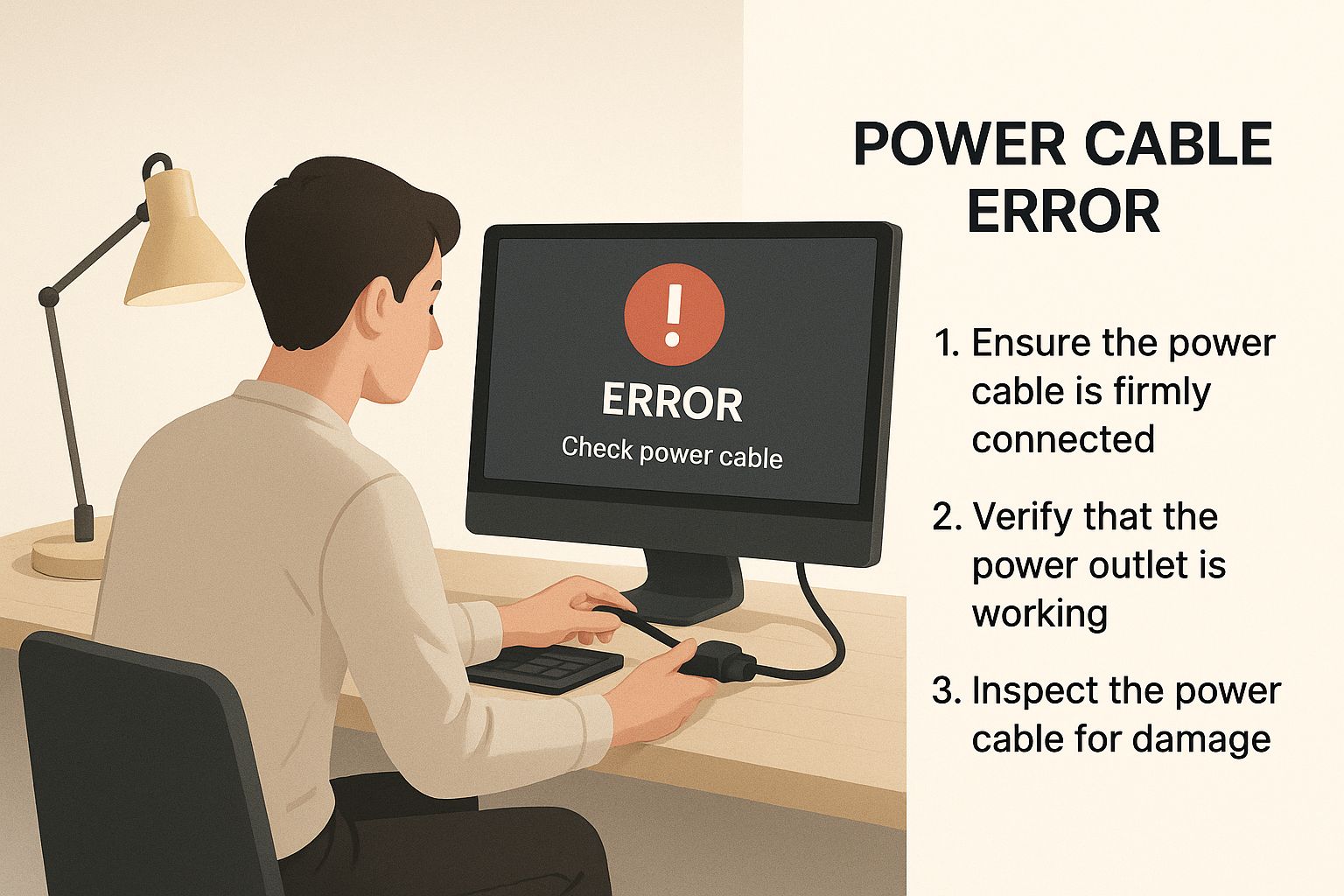When your computer decides to stop working, the first instinct is to Google "computer repair services near me." I get it. The panic sets in. But before you pick up the phone, taking a few minutes to check some simple things can often save you a trip to the shop—and the repair bill that comes with it.
What To Do Before Calling A Technician
We've all been there: you hit the power button, and… nothing. Or maybe you get the dreaded blue screen. It’s frustrating, but don't assume the worst just yet. A little basic triage can tell you a lot about what's going on, helping you figure out if you've got a simple hiccup or a real hardware problem on your hands.
Think of it as first aid for your computer. You're just checking the basics to see how serious the injury is.

As you can see, the first line of defense is often the simplest. Making sure everything is properly connected is a step you can't afford to skip.
Simple Diagnostic Tricks To Try First
Let's start with the most common culprits. It might sound silly, but check your cables. Is the power cord plugged in firmly at both the computer end and the wall outlet? What about your monitor and keyboard? A slightly loose connection is a surprisingly frequent cause of what looks like a major failure. If everything is tight, try a different power outlet just to be sure.
If your computer is turning on but acting strange—freezing up, crashing, or showing that infamous "blue screen of death"—the problem is likely software-related. A great diagnostic tool here is booting into Safe Mode. This starts your computer with just the bare-bones essentials, which can help you pinpoint whether a recently installed program or a bad driver is the troublemaker.
Gather Key Information For The Repair Shop
Okay, so the simple tricks didn't work. Now it's time to gather some intel for the technician. The more information you can provide, the faster and more accurately they can diagnose the issue.
Before you call, jot down the following:
- Device Model and Serial Number: You can usually find this on a sticker on the back or bottom of your machine.
- Exact Error Messages: Don't try to remember them. Snap a quick photo with your phone or write down the exact wording and any error codes you see.
- Recent Changes: Think back. Did you just install new software? Update your operating system? Connect a new printer? This context is pure gold for a technician.
Having this information ready makes the conversation with a repair shop much more productive. It also helps them determine if your issue can be fixed remotely. In fact, you might be surprised at how many software glitches can be resolved without you ever leaving your desk. You can learn more about the benefits of remote support to see if it’s a good fit for your situation.
Quick Comparison of Local Repair Options
To give you a better idea of your options, here’s a quick breakdown of the different types of repair services you'll likely find. This table can help you make a faster, more informed decision based on your specific needs and budget.
| Repair Service Type | Best For | Typical Cost | Turnaround Time |
|---|---|---|---|
| Big-Box Store (e.g., Best Buy) | Common issues on mainstream devices, warranty repairs. | $$ – $$$ | 3-10 days |
| Independent Local Shop | Complex hardware issues, personalized service, data recovery. | $$ – $$$$ | 1-5 days |
| Mobile/On-Site Technician | Convenience, immediate help for network or setup issues. | $$$ – $$$$ | Same-day or next-day |
| Remote Support Service | Software glitches, virus removal, driver issues. | $ – $$ | Immediate |
Ultimately, the right choice depends on your problem's urgency, complexity, and how comfortable you are with the different service models.
Keep your business running without IT headaches.
GT Computing provides fast, reliable support for both residential and business clients. Whether you need network setup, data recovery, or managed IT services, we help you stay secure and productive.
Contact us today for a free consultation.
Call 203-804-3053 or email Dave@gtcomputing.com
How to Vet Local Computer Repair Shops

Okay, so you've got a short list of local computer repair shops. Now the real work starts. It’s easy to just pick the cheapest option, but you’re handing over a device with sensitive data and expensive parts. A little extra digging at this stage can save you a world of hurt later on.
First, go deeper than the star ratings on Google or Yelp. A 4.8-star average is great, but the comments are where the gold is. I always look for patterns. Do you see multiple people mentioning how the technician explained the problem clearly? Or how the final bill matched the quote exactly? That’s what you want to see.
Also, don't skip the negative reviews. Pay close attention to how the shop owner responds. A defensive or dismissive reply is a huge red flag, while a professional, helpful response shows they actually care about their customers.
Key Questions to Ask Before You Commit
Before you even think about handing over your computer, you need to ask a few direct questions. Any technician worth their salt will be happy to answer them. Think of it as a quick interview—you're making sure they're the right person for the job.
Here are the non-negotiables I always recommend asking any potential computer repair service:
- What's your diagnostic fee? Some shops will charge you just to look at the machine, and that fee may or may not go toward the final repair cost. Get this clarified right away so there are no surprises.
- Do you offer a warranty? A reputable shop will always stand behind its work. You should expect a warranty on both the parts and the labor. A 90-day warranty is pretty standard in the industry.
- Are your technicians certified? While not a deal-breaker for a seasoned pro, a certification like CompTIA A+ shows a baseline level of professional knowledge and commitment.
- What's your data privacy policy? This is a big one. You need to be confident they will handle your personal files with care and professionalism. They should have a clear policy for protecting client data.
Don't just rely on what the shop tells you. Spend a few minutes reading through client testimonials. This is where you get the real, unfiltered story about what it's like to work with them. Hearing directly from past customers provides a layer of trust that no marketing pitch can match.
By asking these pointed questions and digging into real customer feedback, you can move past the marketing fluff and find an expert you can truly trust.
Keep your business running without IT headaches.
GT Computing provides fast, reliable support for both residential and business clients. Whether you need network setup, data recovery, or managed IT services, we help you stay secure and productive.
Contact us today for a free consultation.
Call 203-804-3053 or email Dave@gtcomputing.com
What Should Computer Repair Really Cost?
Let’s be honest, nobody wants a surprise bill. When your computer is already on the fritz, the last thing you need is sticker shock from the repair shop. Getting a handle on typical repair costs before you walk in the door is the best way to evaluate quotes, spot a rip-off, and find a fix that doesn’t break the bank.
The final price tag isn't just about what's wrong; it's also about the specific parts needed and the type of computer you have. For example, replacing a cracked screen on a standard Dell laptop is a completely different ballgame than swapping one out on a new MacBook Pro. Apple's parts are just plain more expensive and often require specialized tools, which drives up the labor cost. The same goes for data recovery—pulling a few deleted files is one thing, but salvaging data from a physically damaged hard drive is a complex (and much pricier) process.
A Look at Typical Repair Bills
While costs can swing quite a bit depending on where you live, you can still get a general idea of what to expect. A simple software fix, like getting rid of a virus or just tuning up a sluggish operating system, is usually charged as a flat fee or a standard hourly rate. It's the hardware repairs that tend to make the costs jump.
Here are a few common jobs and a realistic look at what goes into the price:
- Virus & Malware Removal: This is pretty straightforward. Most reputable shops offer this as a flat-fee service because the process is predictable.
- Screen Replacement: The cost here is all over the map. It really depends on the brand, the specific model, and whether you have a touchscreen.
- Hard Drive Replacement: You’re paying for two things: the new drive itself (whether it's a speedy SSD or a traditional HDD) and the labor to install it, reinstall the OS, and hopefully transfer your data over.
- Data Recovery: This is the big one. Pricing can range from reasonable for simple cases to very expensive for severe physical damage requiring a cleanroom environment.
A quick heads-up: Global supply chain hiccups can throw a wrench in local pricing. If a specific screen model or chip is suddenly hard to get, the cost for that repair can spike overnight—something your local tech has zero control over.
The demand for good, reliable repair isn't going anywhere. In fact, the global market for software used by repair shops is projected to grow from $141 million in 2025 to $154 million by 2033. This growth is all about consumers like you wanting effective, transparent tech support. To see exactly what different services cost, you can take a look at our transparent repair pricing for a clear breakdown.
Keep your business running without IT headaches.
GT Computing provides fast, reliable support for both residential and business clients. Whether you need network setup, data recovery, or managed IT services, we help you stay secure and productive.
Contact us today for a free consultation.
Call 203-804-3053 or email Dave@gtcomputing.com
On-Site vs. Drop-Off Repair: What's Right for Your Problem?
When you start looking for local computer help, you'll quickly see two main options: they come to you, or you go to them. Figuring out which one makes more sense isn't just about convenience; it's about getting the fastest, most effective fix for your specific issue.
The appeal of on-site service is obvious. A technician showing up at your door is perfect for problems that involve your whole setup. Think about a Wi-Fi network that keeps dropping, a new printer that won't talk to any of your computers, or setting up a network for your home office. In these cases, the technician needs to be there to see how all the pieces are (or aren't) working together in their natural environment.
When Dropping It Off Is the Smarter Move
On the other hand, some problems are best handled back at the shop. Serious hardware issues—like a dead motherboard, a shattered laptop screen, or a tricky data recovery job on a failed hard drive—are prime candidates for drop-off service.
These kinds of intensive repairs require specialized diagnostic tools, a clean workspace, and sometimes, a lot of time. A technician might need to order specific parts and run tests for hours. Leaving your machine with them lets them do the deep work without turning your kitchen table into a C.S.I. lab.
The real key is understanding the problem's source. For example, if your computer can't get online, is it a software glitch, a bad network card, or is your router on the fritz? A quick phone call with the repair shop can usually sort this out and point you in the right direction.
Don't Forget About Remote Support
There's also a third option that's incredibly efficient for software troubles: remote support. If you're dealing with a virus, need help installing a program, or just want a system tune-up, a technician can often log into your computer securely and fix it right then and there. It saves everyone time and a trip.
This kind of efficiency is where the whole industry is heading. The Electronic and Computer Repair Services market is massive, projected to hit $21.0 billion in 2025, largely because services are becoming more streamlined. You can read a full analysis of the changing computer repair market to see how things are evolving.
Keep your business running without IT headaches.
GT Computing provides fast, reliable support for both residential and business clients. Whether you need network setup, data recovery, or managed IT services, we help you stay secure and productive.
Contact us today for a free consultation.
Call 203-804-3053 or email Dave@gtcomputing.com
Getting Your Computer Ready for the Repair Shop

Before you hand your device over to a local pro, taking a few minutes to prep it can make a world of difference. These simple steps don't just protect your private information; they also help the technician figure out what’s wrong much faster. That means less time in the shop and, often, a lower bill for you.
First and foremost, back up your data. I can't stress this enough. Even a seemingly simple repair can go sideways, and the risk of data loss is always there. The easiest way is to copy everything to an external hard drive or use a cloud service like Google Drive or OneDrive. Your photos, documents, and memories are priceless—don't take a chance.
Protect Your Privacy
With your files safely backed up, your next priority is privacy. Make it a habit to log out of everything. We're talking email, social media, online banking—any application that holds your personal info. Reputable techs are professionals, but this is a simple, smart precaution that gives you total peace of mind.
Then, there's the matter of your password. The technician will almost certainly need to log in to run diagnostics and test the fix. Here’s how I advise my clients to handle it:
- Set a temporary password. Create something simple you don't use anywhere else and give that to the tech.
- Remove the password entirely. This is another easy option, but only do it temporarily.
- Never share your main password. It's just not a good security practice.
Whatever you do, remember to change back to your secure password the moment you get your computer home. It's the final step to buttoning up your security.
Lastly, give the technician a hand by documenting the problem. Write down exactly what's happening. When did it start? Are there specific error messages? Even better, grab your phone and take a quick video of the issue as it occurs. This kind of context is gold for a technician and helps them get straight to the root of the problem.
Keep your business running without IT headaches.
GT Computing provides fast, reliable support for both residential and business clients. Whether you need network setup, data recovery, or managed IT services, we help you stay secure and productive.
Contact us today for a free consultation.
Call 203-804-3053 or email Dave@gtcomputing.com
Don't Just Fix the Computer—Fix the Office
When your laptop dies, your first instinct is probably to find someone who can fix it, fast. But that single broken machine might just be the tip of the iceberg.
Think about the other little tech headaches that pop up. The office printer that randomly disconnects. The scanner that won't talk to the network. If you're calling a different person for every gadget, you're not just wasting time—you're playing a frustrating game of tech whack-a-mole.
This is why a simple search for "computer repair" can be short-sighted. Instead, it often makes more sense to look for a partner who can manage your entire tech environment. You want someone who sees the whole picture: how your computers, network, printers, and other peripherals are all supposed to play nicely together.
Think Bigger Than a Single Broken Device
This integrated approach is a game-changer, especially for a home office or a growing small business. When one technician or company knows your entire setup, they can get to the root of a problem much faster. They're not just putting a bandage on the symptom; they're diagnosing the underlying issue.
Maybe that "slow computer" is actually caused by a network bottleneck affecting everyone. Or that new scanner just needs to be configured correctly from the get-go. A holistic view prevents these small fires from starting in the first place.
This is a huge part of the modern tech support industry. The global market for computer and office machine repair is a massive field, covering everything from high-end PCs to the trusty office photocopier. As businesses try to get the most out of their equipment, the demand for comprehensive support keeps growing. You can dig into the numbers in this in-depth market research on office machine repair.
This approach saves you from becoming the middleman. You won't have to waste time explaining what the "computer guy" said to the "printer guy." A single point of contact streamlines everything and ensures all your tech actually works as a system.
Ultimately, finding a service that can support your whole office isn't just about fixing today's problem. It’s about building a relationship with an expert who can help your technology scale as your business grows, keeping everything efficient, secure, and reliable down the road.
Keep your business running without IT headaches.
GT Computing provides fast, reliable support for both residential and business clients. Whether you need network setup, data recovery, or managed IT services, we help you stay secure and productive.
Contact us today for a free consultation.
Call 203-804-3053 or email Dave@gtcomputing.com
Choosing Your Technician and Moving Forward
Alright, you've done the legwork. You’ve figured out what’s wrong, scouted the local repair shops, and have a good idea of what this is all going to cost. Now comes the moment of truth: picking the right person for the job and handing over your machine.
Before you pull the trigger, there are just a few final details to lock down. This isn't about being difficult; it's about making sure everyone is on the same page and avoiding any nasty surprises later. Think of it as dotting the i's and crossing the t's on your service agreement.
Your Final Pre-Repair Sanity Check
Consider this your last chance to confirm everything before the work actually starts. Any trustworthy repair shop will be happy to answer these questions and put your mind at ease.
- Get It in Writing: A verbal estimate is fine for a ballpark figure, but always insist on a written quote. It should clearly break down the costs for parts, labor, and any diagnostic fees. This simple piece of paper protects both of you.
- Lock Down the Timeline: Get a realistic estimate for when you can expect your device back. More importantly, ask how they’ll keep you in the loop if they run into unexpected problems or delays. A quick text or call can make all the difference.
- Understand the Warranty: Make sure you know exactly what’s covered. Does the warranty apply to just the new parts, or the labor as well? A 90-day warranty is pretty standard and shows the technician stands behind their work.
Taking these last few steps turns you from a passive customer into an informed partner. It’s all about creating clarity so that when you pick up your repaired device, the only surprise is how well it works.
You’ve successfully navigated the maze of finding a local expert you can rely on. Now you can hand over your tech with confidence, knowing it’s in truly capable hands.
Keep your business running without IT headaches.
GT Computing provides fast, reliable support for both residential and business clients. Whether you need network setup, data recovery, or managed IT services, we help you stay secure and productive.
Contact us today for a free consultation.
Call 203-804-3053 or email Dave@gtcomputing.com



